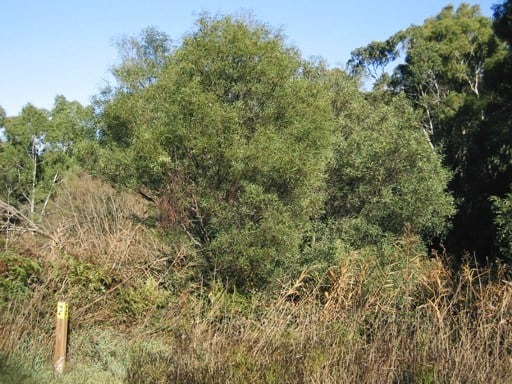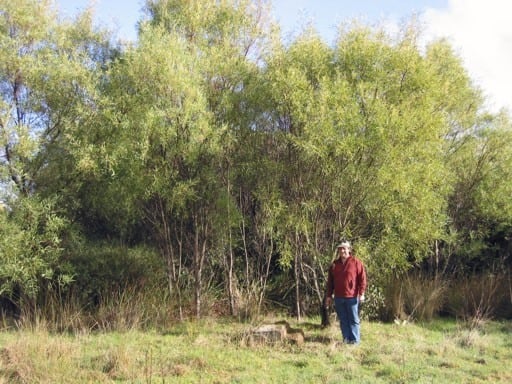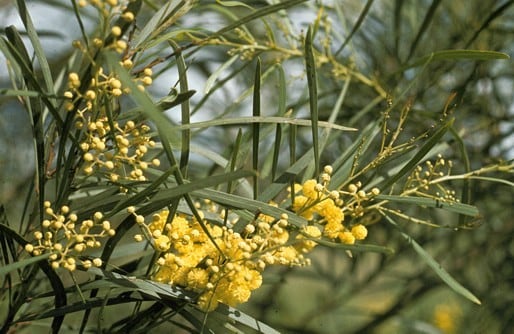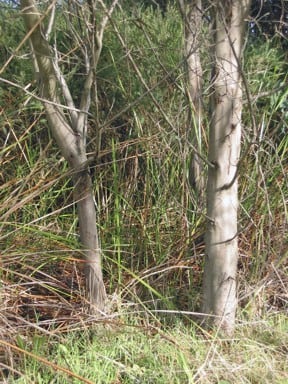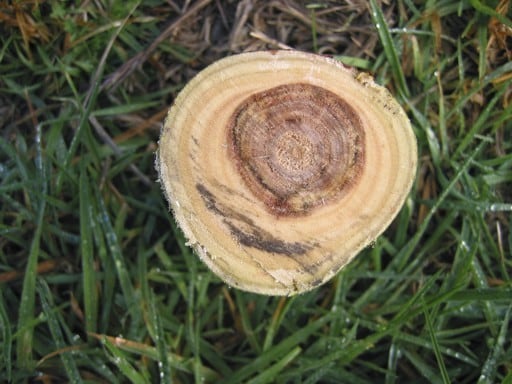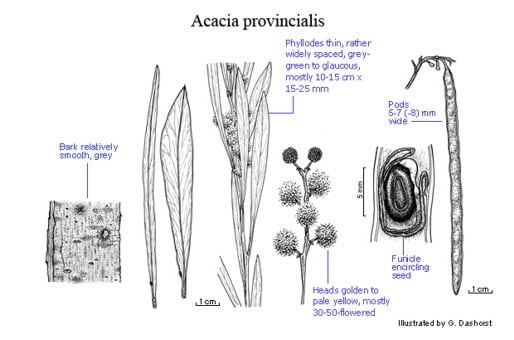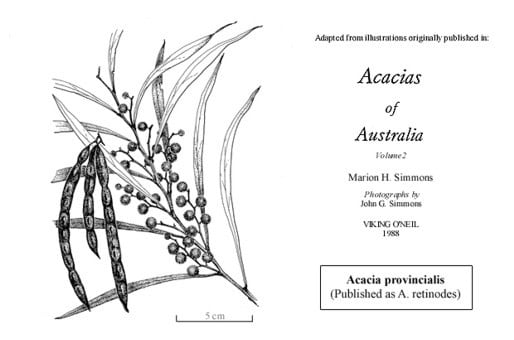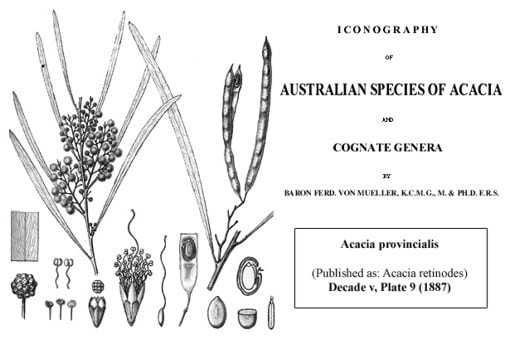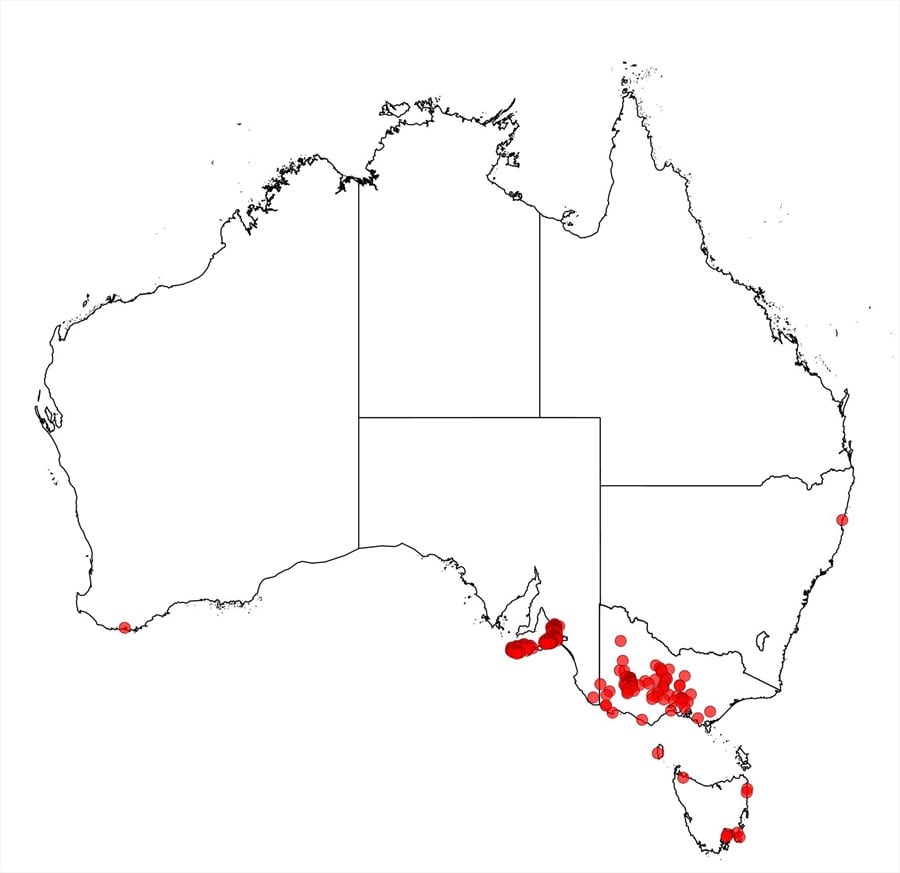Acacia provincialis A.Camus
WATTLE
Acacias of Australia
Common Name
Wirilda, Wirrildar, Swamp Wattle, Water Wattle, Perennial Wattle, Ever Flowering Wattle, Ever Blooming Wattle, Bold Wattle, Mimosa of Four Seasons
Family
Fabaceae
Distribution
Discontinuous in south-eastern Australia where it extends from near Mt Crawford in the Mt Lofty Ranges, S through Fleurieu Penin. to Kangaroo Is., S.A., also in Vic. in the Grampians, along the Glenelg R. to near Melbourne. In Tas. a record from Currie, King Is., requires study to determine if it represents a natural occurrence, and a specimen from Launceston is possibly from a cultivated plant.
Description
Tree 5–10 m high, not suckering. Bark smooth, grey. Branchlets prominently flattened and angular, often lightly pruinose, glabrous. Phyllodes variable, uncrowded on stems (10–20 mm apart), straight to shallowly recurved, narrowly oblanceolate or narrowly elliptic, 10–15 cm long, 15–25 (–35) mm wide, (linear, 10–20 cm long and 4–10 mm wide on juvenile plants), grey-green to glaucous, often lightly pruinose, glabrous, 1-nerved per face, obscurely penninerved; gland normally single (rarely 2–4), 0–16 mm above pulvinus. Inflorescences racemose; raceme axes 2–4 (–5) cm long; peduncles (3–) 4–5 (–7) mm long, glabrous; heads globular, (18–) 30–50 (–54)-flowered, golden to pale yellow. Flowers 5‑merous; sepals united; ovary glabrous. Pods linear, to 16 cm long, 5–7 (–8) mm wide, firmly chartaceous. Seeds longitudinal, oblong to oblong-elliptic, 4–6 mm long, dark brown to black; funicle 3/4 or more encircling seed, red-brown to blackish; aril clavate.
Phenology
Flowers throughout the year with peaks in Sept.–Oct. and Dec.–Jan.
Habitat
Favours damp soils along watercourses, swamps and valley slopes.
Specimens
S.A.: Kangaroo Is., Church rd, 2 km W of West End Hwy, D.J.Duval & M.K.Jones 52 (AD, CANB, K, STU); Mount Lofty Ra., southern boundary of Kyeema Cons. Park, B.R.Maslin 8354 (AD, PERTH). Vic.: Grampians, S.T.Parfett 13 (AD, MEL, NSW, PERTH); Banks of Glenelg R., 10 Nov. 1963, J.H.Willis (MEL).
Notes
The variation in phyllode morphology is related to the biological age of plants. Specimens from western Kangaroo Is. can have very broad phyllodes (to 35 mm) with up to 4 glands along the adaxial margin. For more detailed discussion of variation (including that relating to habit) see M.C.O’Leary, J. Adelaide Bot. Gard. 21: 106–107 (2007).
A member of the ‘Acacia microbotrya group’ most closely related to A. uncifolia and A. retinodes, differing from the latter in smooth, grey bark, often pruinose branchlets and phyllodes that are uncrowded on stems, more numerous flowers per head that are pale yellow to golden and broader pods (see A. uncifolia for differences relating to that species; see also M.C.O’Leary, J. Adelaide Bot. Gard. 21: 97 Table 1 (2007)).
Information on the biological and ecological features, and the utilisation potential, of this species is given in B.R.Maslin and M.W.McDonald, AcaciaSearch: Evaluation of Acacia as a woody crop option for southern Australia, RIRDC Publication No. 03/017, 176–180 (2004).
When first described A. provincialis was thought to be a garden hybrid between A. retinodes and A. cyanophylla (= A. saligna); it was treated as conspecific with A. retinodes by B.R.Maslin, Fl. Australia 11A: 281 (2001). However, a revision of A. retinodes by M.C.O’Leary, J. Adelaide Bot. Gard. 21: 95–109 (2007) has shown that A. provincialis is not a hybrid and warrants recognition as a distinct species.
FOA Reference
Data derived from Flora of Australia Volumes 11A (2001), 11B (2001) and 12 (1998), products of ABRS, ©Commonwealth of Australia
Author
B.R.Maslin
B.R.Maslin, M.O'Leary
This identification key and fact sheets are available as a mobile application:
URL: https://apps.lucidcentral.org/wattle/
© Copyright 2018. All rights reserved.
